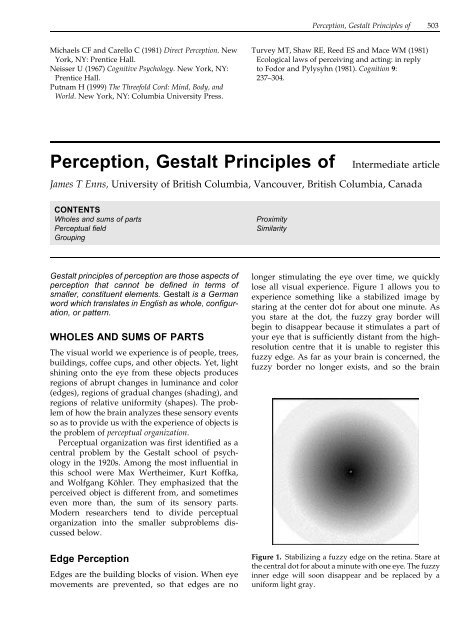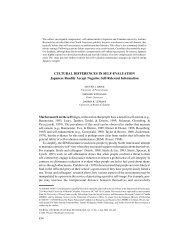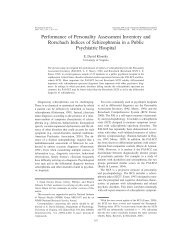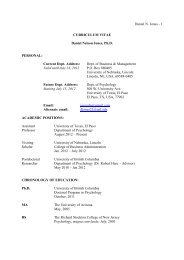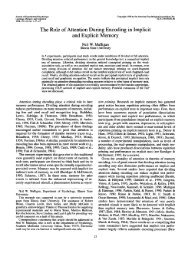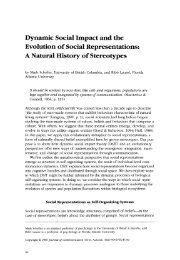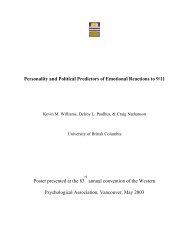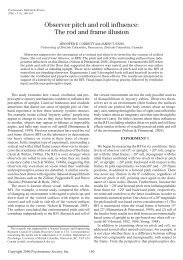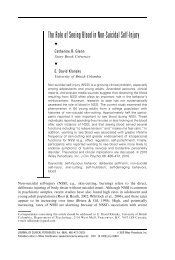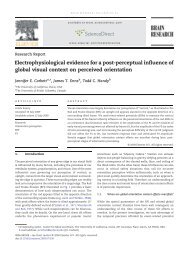Gestalt Grouping Principles - HomePage Server for UT Psychology
Gestalt Grouping Principles - HomePage Server for UT Psychology
Gestalt Grouping Principles - HomePage Server for UT Psychology
You also want an ePaper? Increase the reach of your titles
YUMPU automatically turns print PDFs into web optimized ePapers that Google loves.
Perception, <strong>Gestalt</strong> <strong>Principles</strong> of 503<br />
Michaels CF and Carello C (1981) Direct Perception. New<br />
York, NY: Prentice Hall.<br />
Neisser U (1967) Cognitive <strong>Psychology</strong>. New York, NY:<br />
Prentice Hall.<br />
Putnam H (1999) The Threefold Cord: Mind, Body, and<br />
World. New York, NY: Columbia University Press.<br />
Turvey MT, Shaw RE, Reed ES and Mace WM (1981)<br />
Ecological laws of perceiving and acting: in reply<br />
to Fodor and Pylysyhn (1981). Cognition 9:<br />
237±304.<br />
Perception, <strong>Gestalt</strong> <strong>Principles</strong> of<br />
Intermediate article<br />
James T Enns, University of British Columbia, Vancouver, British Columbia, Canada<br />
CONTENTS<br />
Wholes and sums of parts<br />
Perceptual field<br />
<strong>Grouping</strong><br />
Proximity<br />
Similarity<br />
<strong>Gestalt</strong> principles of perception are those aspects of<br />
perception that cannot be defined in terms of<br />
smaller, constituent elements. <strong>Gestalt</strong> is a German<br />
word which translates in English as whole, configuration,<br />
or pattern.<br />
WHOLES AND SUMS OF PARTS<br />
The visual world we experience is of people, trees,<br />
buildings, coffee cups, and other objects. Yet, light<br />
shining onto the eye from these objects produces<br />
regions of abrupt changes in luminance and color<br />
(edges), regions of gradual changes (shading), and<br />
regions of relative uni<strong>for</strong>mity (shapes). The problem<br />
of how the brain analyzes these sensory events<br />
so as to provide us with the experience of objects is<br />
the problem of perceptual organization.<br />
Perceptual organization was first identified as a<br />
central problem by the <strong>Gestalt</strong> school of psychology<br />
in the 1920s. Among the most influential in<br />
this school were Max Wertheimer, Kurt Koffka,<br />
and Wolfgang KoÈhler. They emphasized that the<br />
perceived object is different from, and sometimes<br />
even more than, the sum of its sensory parts.<br />
Modern researchers tend to divide perceptual<br />
organization into the smaller subproblems discussed<br />
below.<br />
longer stimulating the eye over time, we quickly<br />
lose all visual experience. Figure 1 allows you to<br />
experience something like a stabilized image by<br />
staring at the center dot <strong>for</strong> about one minute. As<br />
you stare at the dot, the fuzzy gray border will<br />
begin to disappear because it stimulates a part of<br />
your eye that is sufficiently distant from the highresolution<br />
centre that it is unable to register this<br />
fuzzy edge. As far as your brain is concerned, the<br />
fuzzy border no longer exists, and so the brain<br />
Edge Perception<br />
Edges are the building blocks of vision. When eye<br />
movements are prevented, so that edges are no<br />
Figure 1. Stabilizing a fuzzy edge on the retina. Stare at<br />
the central dot <strong>for</strong> about a minute with one eye. The fuzzy<br />
inner edge will soon disappear and be replaced by a<br />
uni<strong>for</strong>m light gray.
504 Perception, <strong>Gestalt</strong> <strong>Principles</strong> of<br />
concludes that the light gray region (which is defined<br />
by a sharp border) is continuous.<br />
Edges interact in cooperative and competitive<br />
ways (Field and Hayes, 1993). This can be seen at<br />
work in Figure 2, where a large O-shape has been<br />
drawn in two ways. In Figure 2(a), the easily seen O<br />
is defined by line segments whose extensions <strong>for</strong>m<br />
a continuous curved arc. In Figure 2(b) the same O-<br />
shape has been drawn, using the same number of<br />
line segments, but the line segments now lie at a 90-<br />
degree angle to the arc of the curve. The O is now<br />
very difficult to see and you will have to inspect<br />
individual segments to confirm it. This illustrates<br />
the cooperation that exists between nearly continuous<br />
edges and the competition that exists between<br />
edges of different orientation.<br />
Feature Extraction<br />
When observers are asked to respond rapidly to<br />
image features, it is apparent that certain features<br />
are more basic, including luminance, color, the<br />
principal axis of a shape, and shape curvature.<br />
Tasks that require observers to respond rapidly to<br />
arbitrary combinations of these features are generally<br />
done slowly and with many errors (Beck, 1982;<br />
Julesz, 1984; Treisman, 1986). However, there are<br />
some combinations that do permit rapid analysis.<br />
These are emergent features since they <strong>for</strong>m gestalts<br />
that cannot be predicted from the component features<br />
(Pomerantz, 1986). Examples are shown in<br />
Figure 3 (Enns and Rensink, 1991; Nakayama and<br />
Silverman, 1986; Ramachandran, 1988).<br />
other shapes as belonging to the background is<br />
one of the crowning achievements of vision. It permits<br />
actions that are appropriate to objects in the<br />
environment, based solely on vision. Some of the<br />
complexities involved in the analysis are illustrated<br />
in Figure 4, a version of the ambiguous face±vase<br />
figure made famous by Rubin (1921). Observers of<br />
this display may see a pair of silhouette faces<br />
gazing at each other or they may see an ornate<br />
vase. The two interpretations also alternate in consciousness<br />
over time, illustrating that the assignment<br />
of figure and background is a product of brain<br />
processes, and not one determined by the image.<br />
Element + Element Emergent feature<br />
Figure 3. Component elements that create emergent<br />
features when combined.<br />
Figural Assignment<br />
The assignment of some shapes as belonging to<br />
objects that are important to the observer and<br />
(a)<br />
(b)<br />
Figure 2. O-shaped configurations defined by (a) nearly<br />
continuous line segments, and (b) the same number of<br />
line segments oriented at 90 degrees to the continuous<br />
curve.<br />
Figure 4. A display that can be seen either as a pair of<br />
black faces or as an ornate white vase.
Perception, <strong>Gestalt</strong> <strong>Principles</strong> of 505<br />
Three-dimensional Structure<br />
Once a three-dimensional interpretation has been<br />
made of the figures in an image, the object can be<br />
acted upon by the motor systems of the organism.<br />
The leading theories in this area have proposed that<br />
shapes in the image are assigned to volumetric<br />
primitives, or simple, convex solids that comprise<br />
the three-dimensional building blocks of vision<br />
(Biederman, 1987).<br />
PERCEPTUAL FIELD<br />
Perceptual field has two distinct meanings <strong>for</strong><br />
<strong>Gestalt</strong> perception. An older sense derives from<br />
the early <strong>Gestalt</strong> theories of brain processes as<br />
analogous to electrical <strong>for</strong>ce fields. As illustrated<br />
in Figure 5(a), <strong>Gestalt</strong> theories claimed that a single<br />
dot viewed on an otherwise blank page, in analogy<br />
to a charged particle, had a <strong>for</strong>ce that spreads out<br />
uni<strong>for</strong>mly in all directions. They hypothesized that<br />
if a second dot were added, as in Figure 5(b), the<br />
two fields of energy would interact. The <strong>Gestalt</strong><br />
psychologists hoped that such neural interactions<br />
would begin to explain perception. However, this<br />
theory failed because neuroscientists were unable<br />
to find brain mechanisms that followed these patterns.<br />
Instead, the dominant metaphor <strong>for</strong> neurons<br />
is the electronic circuit, which means that neurons<br />
can per<strong>for</strong>m simple arithmetic operations. In the<br />
modern view, neurons do interact with one another<br />
in excitatory and inhibitory ways but these interactions<br />
do not resemble the spread of energy<br />
around magnetic dipoles.<br />
A second sense of perceptual field refers to the<br />
spatial region over which vision functions. Only a<br />
(a)<br />
+<br />
(b)<br />
Figure 5. (a) A single particle with a positive electrical<br />
charge. (b) The same particle along with a nearby particle<br />
with a negative charge. Lines illustrate the electrical field<br />
<strong>for</strong>ces.<br />
subset of the entire field of view is at any moment<br />
contributing to the per<strong>for</strong>mance of the task. Some<br />
researchers refer to this as the useful field of view.<br />
Consider how the perceptual field differs depending<br />
on the task. If the task is to detect a bright light<br />
flashed anywhere in the visual field, the visual field<br />
is usually estimated to be almost 180 degrees wide<br />
and 100 degrees high. However, if the task is to<br />
read letters in a standard row of text, without<br />
moving the eyes, then the perceptual field may<br />
shrink to only 4±6 degrees wide.<br />
Modern research emphasizes the role of attention<br />
in perception. Where an observer attends, and<br />
what the observer expects to see there, has a powerful<br />
effect on what is seen. This dynamic aspect of<br />
perception is studied in tasks where observers are<br />
asked to detect changes in scenes that are separated<br />
by a shift in viewpoint (Simons, 2000) or a short<br />
temporal interval (Rensink et al., 1997). The main<br />
finding is that observers are `blind' to changes in<br />
objects they were not attending to. In other studies,<br />
observers per<strong>for</strong>m a visually demanding task and<br />
then are suddenly and briefly shown a surprise<br />
stimulus. The detection of these unannounced<br />
stimuli is so infrequent that the term inattentional<br />
blindness has been coined (Mack and Rock, 1998).<br />
These studies emphasize the `piecemeal nature' of<br />
perception (Hochberg, 1982) and that very little of<br />
the available in<strong>for</strong>mation is consciously registered<br />
(Shapiro, 1994).<br />
GROUPING<br />
Which parts of an image belong together and which<br />
belong to different objects? This is the problem of<br />
grouping that early <strong>Gestalt</strong> psychologists are best<br />
known <strong>for</strong>. Wertheimer (1923) went so far as to call<br />
his answers `laws', since he believed them to be as<br />
reliable as other physical laws. Today reseachers<br />
tend to use the term principle to reflect their important,<br />
but not absolute, influence on perception.<br />
The classic <strong>Gestalt</strong> principles were illustrated<br />
using the elements of dots and line segments.<br />
They included the principle of proximity (elements<br />
that are relatively close tend to be seen as belonging<br />
to the same perceptual unit), similarity (elements<br />
that are relatively similar tend to be seen as<br />
belonging together), good continuation (elements<br />
following a simple curve will tend to be grouped<br />
together), common fate (elements with common<br />
motion direction will tend to cohere), and closure<br />
(elements which enclose a region will tend to be<br />
seen as belonging to the same figure).<br />
Although these principles operate reliably when<br />
applied to the drawings of <strong>Gestalt</strong> psychologists,
506 Perception, <strong>Gestalt</strong> <strong>Principles</strong> of<br />
they are difficult to apply in other settings. There<br />
are several reasons <strong>for</strong> this failure. First, the `elements'<br />
of perception were never defined. Un<strong>for</strong>tunately,<br />
natural images are not coded in the<br />
sharply defined dots and lines used in the drawings<br />
of <strong>Gestalt</strong> researchers. Second, the features to<br />
which `similarity' and `common direction' should<br />
be applied were not defined, making the basis of<br />
similarity unclear. Third, the spatial region over<br />
which the laws applied was not defined. It was<br />
simply assumed that each drawing in its entirety<br />
would submit to the principles in a coherent<br />
manner. This ignores the importance of attentional<br />
limits on perceptual field size (Hochberg, 1982).<br />
Some limitations of the classic <strong>Gestalt</strong> view are<br />
being addressed by modern research. For instance,<br />
one proposal defines the elements of an image as<br />
regions of common brightness (Palmer and Rock,<br />
1994). Elements so defined are then grouped<br />
further based on a principle of common region<br />
(elements located within the same enclosed region<br />
of space will tend to be grouped) and element connectedness<br />
(elements in physical contact with other<br />
elements will tend to be grouped). However, the<br />
initial elements defined by common brightness<br />
may also be parsed in greater detail, using the<br />
heuristic of segmentation at regions of deep concavity.<br />
Examples of these principles are shown in Figure 6.<br />
example, is the relevant distance <strong>for</strong> grouping by<br />
proximity the retinal image or distance in threedimensional<br />
space? This question has been studied<br />
by creating a dot lattice using luminous beads attached<br />
to threads, as shown in Figure 7(Rock,<br />
1997). If observers see the dots as lying in a plane<br />
perpendicular to the line of sight, then grouping is<br />
influenced primarily by the proximity between<br />
dots as measured in the retinal image. On the<br />
other hand, if they perceive the dots as part of a<br />
surface receding in depth, then the apparent proximity<br />
of the dots on the surface determines whether<br />
row or column grouping is seen. Related experiments<br />
have studied the relations between perceived<br />
proximity and the perceptual completion<br />
of partially occluding objects. In all cases, it is<br />
clear that grouping mechanisms based on proximity<br />
work in cooperation with other processes such<br />
as depth perception. Similar findings have been<br />
reported <strong>for</strong> grouping by temporal proximity (Lee<br />
and Blake, 1999).<br />
SIMILARITY<br />
Whereas early <strong>Gestalt</strong> researchers assumed that<br />
similarity was based on such obvious properties<br />
as color, brightness, and shape, more recent studies<br />
have shown that this too is task-dependent.<br />
PROXIMITY<br />
An important question <strong>for</strong> modern research is the<br />
perceptual space in which grouping occurs. For<br />
A<br />
C<br />
D<br />
B<br />
Figure 6. Illustrations of several new principles of<br />
grouping (Palmer and Rock, 1994). (A) Common brightness:<br />
the two `bubbles' are grouped because they share<br />
brightness. (B) Common region: the two pairs of bubbles<br />
are grouped because they are enclosed by a common<br />
outline. (C) Element connectedness: the pairs of bubbles<br />
are grouped because they are joined by a bar. (D) Image<br />
segmentation based on concavities: the two bubbles are<br />
seen as separate objects because of the concavities in the<br />
surrounding edge.<br />
Figure 7. <strong>Grouping</strong> by proximity depends on whether<br />
lattices such as these are seen as lying perpendicular to<br />
the line of sight or as receding in depth.
Perception, <strong>Gestalt</strong> <strong>Principles</strong> of 507<br />
Figure 8. <strong>Grouping</strong> by similarity in dense textures follows different rules from grouping by similarity of individual<br />
texture elements.<br />
Consider, <strong>for</strong> example, whether an L-shape or a<br />
tilted T-shape is more similar to an upright T-<br />
shape. When observers are shown this triplet of<br />
elements in isolation, they tend to agree that the<br />
tilted and upright Ts are more similar to each other<br />
than either one of these two is to the L-shape.<br />
However, as shown in Figure 8, when large<br />
numbers of these shapes are used to <strong>for</strong>m a texture,<br />
borders are <strong>for</strong>med where regions of uni<strong>for</strong>m elements<br />
meet one another. Now it is clear that the<br />
strongest border lies between the upright Ts and<br />
the tilted Ts (Beck, 1982). This demonstrates that<br />
similarity varies with the visual task. Seeing a<br />
dense texture of elements leads to an emphasis on<br />
differences in element orientation, whereas seeing<br />
elements in isolation permits an analysis of the<br />
spatial relations among component segments.<br />
In studies of perceived brightness and similarity,<br />
it has been shown that grouping depends on the<br />
apparent brightness, not on the physical luminance<br />
intensities of elements (Adelson, 1993;<br />
Rock, 1997). This means that observers take into<br />
account the role of shadows and assumed light<br />
sources in their evaluation of similarity based on<br />
luminance. As such, it also demonstrates once<br />
again that visual grouping does not operate in isolation<br />
from other perceptual processes, especially<br />
those involved in the interpretation of an image as<br />
being generated by light reflecting from threedimensional<br />
surfaces.<br />
References<br />
Adelson EH (1993) Perceptual organization and the<br />
judgment of brightness. Science 262: 2042±2044.<br />
Beck J (1982) Textural segmentation. In: Beck J (ed.)<br />
Organization and Representation in Perception,<br />
pp. 285±318. Hillsdale, NJ: Lawrence Erlbaum.<br />
Biederman I (1987) Recognition-by-components: a theory<br />
of human image understanding. Psychological Review 94:<br />
115±147.<br />
Enns JT and Rensink RA (1991) Preattentive recovery of<br />
three-dimensional orientation from line drawings.<br />
Psychological Review 98: 335±351.<br />
Field DJ and Hayes A (1993) Contour integration by the<br />
human visual system: evidence <strong>for</strong> a local `association<br />
field'. Vision Research 33: 173±193.<br />
Hochberg J (1982) How big is a stimulus? In: Beck J<br />
(ed.) Organization and Representation in Perception,<br />
pp. 191±218. Hillsdale, NJ: Lawrence Erlbaum.<br />
Julesz B (1984) A brief outline of the texton theory of<br />
human vision. Trends in Neuroscience 7: 41±45.<br />
Lee S-H and Blake R (1999) Visual <strong>for</strong>m created solely<br />
from temporal structure. Science 284: 1165±1168.<br />
Mack A and Rock I (1998) Inattentional Blindness.<br />
Cambridge, MA: MIT Press.<br />
Nakayama K and Silverman GH (1986) Serial and<br />
parallel processing of visual feature conjuctions. Nature<br />
320: 264±265.
508 Perception, <strong>Gestalt</strong> <strong>Principles</strong> of<br />
Palmer SE and Rock I (1994) Rethinking perceptual<br />
organization: the role of uni<strong>for</strong>m connectedness.<br />
Psychonomic Bulletin & Review 1: 29±55.<br />
Pomerantz JR (1986) Visual <strong>for</strong>m perception: an<br />
overview. In: Schwab EC and Nusbaum HC (eds)<br />
Pattern Recognition by Humans and Machines, vol. 2:<br />
Visual Perception, pp. 1±30. Orlando, FL: Academic<br />
Press.<br />
Ramachandran VS (1988) Perceiving shape from shading.<br />
Scientific American 259: 76±83.<br />
Rensink RA, O'Regan JK and Clark JJ (1997) To see or not<br />
to see: the need <strong>for</strong> attention to perceive changes in<br />
scenes. Psychological Science 8: 368±373.<br />
Rock I (1997) Indirect Perception. Cambridge, MA: MIT<br />
Press.<br />
Rubin E (1921) Visuell wahrgenommene Figuren.<br />
Copenhagen, Denmark: Glydendalske.<br />
Shapiro KL (1994) The attentional blink: the brain's<br />
eyeblink. Current Directions in <strong>Psychology</strong> 3: 86±89.<br />
Simons DJ (2000) Attentional capture and inattentional<br />
blindness. Trends in Cognitive Science 4: 147±155.<br />
Treisman AM (1986) Features and objects in visual<br />
processing. Scientific American 255: 114B-125.<br />
Wertheimer M (1923) <strong>Principles</strong> of perceptual<br />
organization. Abridged translation by M Wertheimer.<br />
In: Beardslee DS and Wertheimer M (eds) Readings in<br />
Perception, pp. 115±137. Princeton, NJ: Van Nostrand-<br />
Reinhold. [Original work published 1923, Psychologische<br />
Forschung 41: 301±350.]<br />
Further Reading<br />
Coren S, Ward LM and Enns JT (1999) Sensation and<br />
Perception, 5th edn. New York, NY: Harcourt Brace.<br />
Marr D (1982) Vision. San Francisco, CA: WH Freeman.<br />
Palmer SE (1999) Vision Science. Cambridge, MA: MIT<br />
Press.<br />
Perception, Haptic<br />
Introductory article<br />
Roberta L Klatzky, Carnegie Mellon University, Pittsburgh, Pennsylvania, USA<br />
Susan J Lederman, Carnegie Mellon University, Pittsburgh, Pennsylvania, USA<br />
CONTENTS<br />
Introduction<br />
Haptic perception of space within reach of the hands<br />
Haptic perception of two-dimensional patterns<br />
Perception of objects and their properties<br />
Haptic memory<br />
Applications of research<br />
Haptic perception is that derived from the sense of<br />
touch.<br />
INTRODUCTION<br />
The word `haptic' comes from a Greek term meaning<br />
`able to lay hold of'. Another word of Greek<br />
origin, `stereognosis', is often used synonymously,<br />
particularly in medical contexts. Haptic perception<br />
is based on combined sensory inputs from the skin,<br />
muscles, tendons, joints and mucosae exposed<br />
to the environment (particularly in the mouth).<br />
Although these inputs could arise passively, as<br />
when an object is pressed against the skin, more<br />
commonly they result from active, purposive<br />
touch. Special receptors in these sites respond to<br />
stimulation from external surfaces or from a person's<br />
own movement. Receptors that lie within the<br />
skin (cutaneous) include mechanoreceptors, which<br />
respond to pressure; thermal receptors, which respond<br />
to thermal changes; and nociceptors, which<br />
respond to high-intensity, noxious stimulation<br />
such as sharp pricks, extreme pressure or very hot<br />
or cold surfaces. The word `kinesthesis' is used to<br />
describe perception based on mechanoreceptors in<br />
muscles, tendons and joints (and also in the skin of<br />
the hand), which give rise to perceived movement,<br />
position or strain in body parts.<br />
The cutaneous receptors comprise four types, as<br />
defined by the size of the skin surface over which<br />
they detect stimulation (receptive field size) and by<br />
how quickly they cease firing when stimulation<br />
remains constant (rate of adaptation). For example,<br />
a class of mechanoreceptors called slowly adapting<br />
type I (SA-I) has a small receptive field and adapts<br />
slowly, so that it identifies a small area of skin<br />
and gives a sustained response when pressure is<br />
applied there. These attributes enable it to provide


